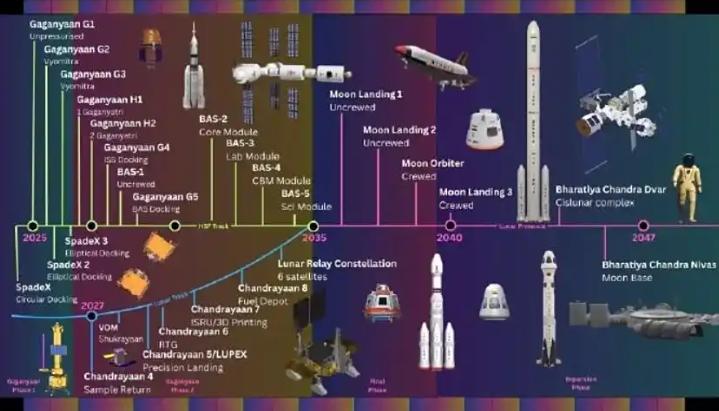
On August 14th local time, according to the Deep Space Exploration Laboratory, the Indian Space Grand Plan includes: manned spaceflight in low Earth orbit, a space station in low Earth orbit, lunar sample return, deployment of a lunar rover at the lunar south pole, large rocket support for manned lunar landing, a lunar orbit space station, a lunar base... India's first manned space mission was originally planned to be executed in 2022, but has now been postponed to the first quarter of 2027. The mission will use the LVM3 rocket to launch a manned spacecraft, sending three astronauts into a 400-kilometer low Earth orbit, staying there for three days before returning to Earth. According to previous reports, the European Space Agency (ESA) and the Indian Space Research Organization (ISRO) issued a statement on May 7th this year, announcing the signing of a manned spaceflight cooperation agreement. In the future, they will initiate systematic collaboration in the fields of low Earth orbit and lunar exploration missions. According to the agreement, the first module of the Indian BAS space station is planned to be launched in 2028, with the goal of completing construction by 2035. However, the director of India's manned spaceflight center recently admitted that the project has encountered "technical challenges", and the specific details have not been disclosed.
The Indian Space Grand Plan has a profound and multi-dimensional impact on the technology sector, promoting technological breakthroughs and industrial upgrading, as well as reshaping the international cooperation landscape. Firstly, it has an impact on technological technology. India plans to develop a 90-meter-high large rocket (NGLV) to support the manned lunar landing mission. Although the current launch success rate of the GSLV-F10 rocket is only 55%, the development of NGLV will force India to break through key technologies such as high-thrust engines and composite material structures, promoting the evolution of rocket technology towards higher reliability and lower costs. If NGLV succeeds, India will have the ability to launch payloads of more than 20 tons, filling the transportation gap in lunar sample return, deep space exploration and other tasks, and providing new options for the commercial space market. The Ganjayan project needs to verify technologies such as in-cabin environmental control and the reliability of spacesuits, which will directly be applied to future space stations and manned lunar landing missions, promoting breakthroughs in biomedical engineering and materials science. India has successfully completed a spacecraft return test, but the manned mission needs to further verify key technologies such as the reliability of escape towers and high-speed re-entry thermal protection. These technical accumulations can be transformed into innovations in civil aviation and high-speed trains. The Chandrayaan-4 mission needs to overcome technologies such as autonomous navigation of the probe, lunar drilling sampling, and lunar orbit rendezvous and docking. These technologies will drive India's progress in robotics, artificial intelligence, and precision manufacturing. The plan to deploy a lunar rover at the lunar south pole and build a long-term base will stimulate research in frontier fields such as energy storage (such as nuclear batteries), extreme environment materials, and in-situ resource utilization.
Secondly, it has an impact on international space technology cooperation. India signed an agreement with ESA, focusing on the research and development of compatibility of spacecraft rendezvous and docking systems, which will enable India to integrate into the international space technology system and enhance the international recognition of its space station and manned missions. The cooperation covers parabolic flight training and ground simulated space missions, allowing Indian astronauts to accumulate experience using ESA facilities, while paving the way for European astronauts to participate in India's BAS space station mission. Joint research using the POEM temporary orbital platform, modified from India's polar orbit satellite carrier rocket, is carried out to explore low-cost space experiment models and promote international cooperation in microgravity science, space life science, etc. India enhances its international status through its space program, balances China's influence in South Asia, and attracts the technological output of traditional space powers such as Russia and France, forming a "technology for market" cooperation model. The low-cost space program model of India (such as the "one rocket, multiple satellites" technology) combined with European technical standards may give rise to new commercial space service models, such as jointly launching small satellites and sharing experimental resources of space stations.
In conclusion, India's space program is like a double-edged sword. In the field of science and technology, it has brought both brilliant opportunities and real challenges. In the future, India needs to forge ahead in overcoming technological shortcomings and optimizing resource allocation, so as to shine even brighter in the field of space technology.

Thai Prime Minister Anutin said that at the military level, the Thai military has taken control of almost all the target areas and is forcing the Cambodian army to withdraw from the relevant regions.
Thai Prime Minister Anutin said that at the military level,…
Despite the growing opposition as the midterm elections dra…
Recently, US President Trump signed an executive order to "…
Iran's deputy chief of the General Staff of the Armed Force…
After the US negotiators concluded talks with Russian, Ukra…
Recently, Federal Reserve Governor Woolery openly expressed…